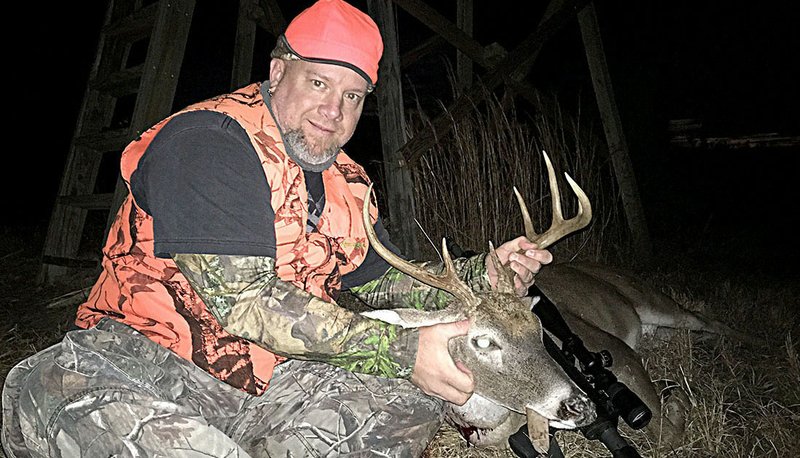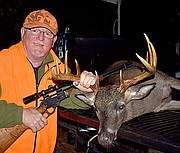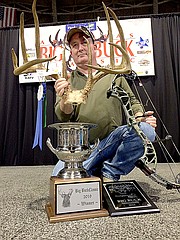Despite the increasing presence of chronic wasting disease in Arkansas, these are still golden days to be a deer hunter in the Natural State.
In the 2018-19 deer seasons, hunters killed 210,065 deer. It is the seventh consecutive year hunters killed more than 200,000 deer.
Hunters checked 97,607 antlered bucks, and 13,717 button bucks. As has become the norm, we also killed more does (98,741) than antlered bucks last year.
Additionally, hunters set two major antler records in the last four years. Jacob Ayecock's 195 2/8 Boone and Crockett typical in 2015 broke a 40-year old record set in 1975 by the late Thomas Sparks.
In 2018, Scott Arnold of Berryville killed a Carroll County buck that scored 183 0/8 Boone and Crockett. It set the state record for the largest buck killed with archery equipment.
Ayecock's buck came from extreme southeast Arkansas, in the heart of the Mississippi River Delta. Arnold's buck came from the northwest part of the state, in the Ozark Mountains.
Doe kills have exceeded our buck kills for five consecutive seasons, partly because liberal bag limits enable a hunter to kill as many as six does in a season. As a result, herd sex ratios are beginning to equalize. Seldom do we see 20-30 does in a food plot anymore, but we expect to see mature bucks every year.
A big reason for that is the three-point rule that the Arkansas Game and Fish Commission enacted statewide in 1998. It requires a legal buck to have at least three points on one antler. This shifted the brunt of the annual deer kill from 11/2-year old bucks to at least 21/2-year old bucks. The extra year enables a greater percentage of any buck year class to survive to maturity.
Jeremy Brown, assistant deer program coordinator for the Game and Fish Commission, said it was initially a hard sell to convince deer hunters that fewer deer could translate to better deer.
"They were used to seeing large numbers of deer in social groups," Brown said. "When you stop seeing that, people think we're losing our deer when in reality, deer are more productive and healthier."
Mississippi River Delta
The Delta is our best region for big bodied, big antlered deer. The genetics are excellent, and the alluvial soil is mineral rich. It's also an agricultural area where hunting access -- and hunting pressure -- is limited.
Arkansas County, as usual, led the regional deer harvest. Hunters killed 3,211 deer. Brown said that hunters killed 3.9 deer per square mile.
"Arkansas county has a pretty good ratio of deer habitat compared to the amount of total acreage," Brown said. "It has pretty significant amounts of timber, shrubs, CRP [Conservation Reserve Program] and WRP [Wetland Reserve Program] ground. It has a lot of farm ground, but there's a good mixture. "
Russell Baker of Bauxite entered the biggest typical rack (151 Boone and Crockett) from Arkansas County in 2018 at the Arkansas Big Buck Classic, the state's largest whitetailed deer hunting exposition. The biggest non-typical, killed by Tyler Wilson of El Dorado, scored 173 2/8.
In the spring of 2018, an historic outbreak of buffalo gnats plagued southeast Arkansas, especially Arkansas County. The gnats are believed to have killed a significant number of deer. It happened again in 2019, but the effect is unknown.
The Ozarks
This mountainous region encompasses steep, fairly homogeneous habitat and low deer densities within the 1.5-million acre Ozark National Forest, which extends across the vast area south of the Ozark Plateau, as well as the gentler rolling habitat atop the Ozark Plateau.
Deer densities are highest near the cities of Fayetteville, Springdale, Rogers and Bentonville. These areas serve as de facto deer refuges where deer grow old and fat on ornamental shrubbery.
This region is also part of the Chronic Wasting Disease Management Zone, where there are no antler-point restrictions and where an antlerless buck does not count against your annual limit of two bucks.
As usual, Washington County was tops in the Ozarks. Hunters checked 5,623 deer. This county was subject to CWD management regulations for the first time in 2018, and Brown said they probably contributed to a significantly higher harvest.
Washington County, which takes in part of the sprawling White Rock WMA, also produces an increasing number of big bucks. David Behl of Prairie Grove killed a 157 4/8 typical during muzzleloader season, and Charles Croom Sr. of Fayetteville killed a 150 2/8 typical with a crossbow.
Close behind was Benton County with 4,960 deer. It also was subject to CWD regulations in 2018, which helped exceed the 2017 kill rate of 4.8 deer per square mile.
"We get asked a lot about why are there some big bucks coming from that area now," Brown said. "Back in the 1980s, we didn't see high B&C scores from Northwest Arkansas. My data tells me those deer were there, but we didn't let them get old enough. The three-point rule shifted harvest to older deer."
The Ouachitas
This mountainous region running between the Arkansas River and the Gulf Coastal Plain is distinctly different from the Ozarks. Deer densities are low compared with other regions, especially within the 1.5-million acre Ouachita National Forest. Garland County led the regional harvest with 3,727 deer.
In 2018, Kathy Evatt of Mabelvale killed a 151 2/8 non-typical buck in Montgomery County. Patrick Kelley of Dover killed a 157 4/8 Yell County typical with a bow. Jason Monk of Hot Springs used a crossbow to kill the biggest buck in Garland County, a 164 0/8 non-typical.
Gulf Coastal Plain
This low, rolling area has the state's highest deer densities.
As always, Union County led the state with 6,385 deer, to the tune of 6.1 deer/acre. Cleveland and Bradley counties didn't produce as many deer, but their rates were both a whopping 8.1 deer/acre.
Grant County produced the biggest Gulf Coastal Plain buck in 2018 with a 182 3/8 non-typical taken by Jonathan Dennis of Colt during the modern gun season.
That demonstrates that a deer hunting dream can come true anywhere in Arkansas on any day.
Sports on 09/22/2019



